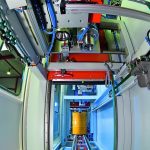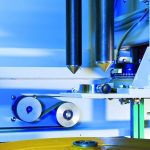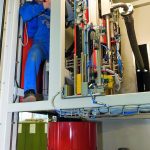Higher speeds and changing requirements often pose specific challenges for the operators of filling systems. Drums, canisters, containers or other receptacles are used depending on the liquid or bulk material. In addition, the properties of the material to be filled are triggers for many more decisions: what form of explosion protection is now needed and will a cleanroom be necessary in the future? In particular, complex plants for high-risk materials call for a sophisticated and future-oriented strategy to ensure consistently reliable operation. Users seeking to adapt their filling systems to current safety standards must regularly examine whether retrofitting the existing system makes eco-nomic sense or whether it might be better to invest in a new one.
Decision on a case-by-case basis
The decision-making process can be illustrated taking the example of an SMB customer in the chemical industry. The company wanted to convert its semiautomated system to support smaller containers – in this case, steel drums – in response to new customer requirements. “Our expert team took a look at the initial situation and immediately noticed that, in addition to the containers themselves, other aspects likewise play an important role in plant conversion”, reports Andreas Heckel, Managing Director of SMB International. “If a system has already been in operation for some time, it may no longer meet current standards and regulations. It might not be approved in this form today. That’s why adapting to current safety stand-ards is also a key task.”
The SMB engineers initially assessed the possibilities for extending the plant’s lifespan. Old assets can often be preserved with the help of new and more advanced technologies. The costs are moderate compared to purchasing a completely new system. “We decide and calculate on a case-by-case basis which variant we recommend to our customers. If the majority of the system components are so obsolete that spare parts are difficult to obtain or have ceased to be available, a retrofit measure is no longer worthwhile in the long run”, Heckel explains.
It is theoretically possible to convert up to 70 %, but with most projects less will also do the job. With 50 % of the components having to be removed, replaced, expanded and equipped with new safety technology, SMB classified the chemical plant as suitable for retrofitting. In close consultation with the customer, Andreas Heckel and his team developed an individual concept to meet future requirements. The goal was to realise an easy-to-use, future-proof filling line that conformed to all the latest safety standards and provided all the functions necessary to increase the company’s productivity.
Safety
Numerous measures were implemented to update the obsolete safety technology to current standards. Light barriers and additional sensors greatly improve occupational safety. The system can even distinguish between containers and people – and stops immediately if the safety limits are exceeded. The new inerting station, too, ensures the highest level of protection. The oxygen from the air is displaced by adding nitrogen, an inert gas, thus preventing the build-up of explosive atmosphere. Ex Zones 1 and 2 were also installed throughout the plant, of course, according to the level of risk and equipped with certified technology.
Automation
Filling plant and system technologies are constantly optimised. For example, SMB has developed its own system for exchanging filling lances automatically, in which the quick-release fastener is pneumatically controlled. A crane system collects the lances via a chain hoist and transports them to the filling station. The extended functions of the filling lances with integrated filling hoses and camera recognition enabled the customer’s process to additionally be optimised in the filling plant. SMB also integrated a new clinch unit, where the drums are automatically provided with lids that are fixed with clamps. Moreover, a calibrated scale ensures that the product quantity always meets the specifications exactly and that the goods leave the production plant ready for sale. The semiautomated system even became fully automated as a result of installing these components.
The complete conveyor system supplied by SMB is precisely matched to the container for a process which is both safe and fast. A user-friendly portal rounds off the improved system. The entire filling process can now be controlled with very little effort, in other words without any restrictions or the previously unavoidable manual intervention, such as opening the drums.
The plant was recommissioned by the chemical company following a three-week conversion phase and a successful FAT (factory acceptance test). Customer-specific documentation, including spare and wear parts lists as well as mechanical drawings of individual assemblies, was provided as part of the final inspection. “Even after commissioning, we attach great importance to customer satisfaction. This is why we compile the documentation according to each client’s specific standards and are always available to answer questions – as well as for training and maintenance contracts if required”, says Heckel. “To enable us to develop customised plants in a short time at our in-house facility, we have opted for a high level of vertical integration.” The engineers in Quickborn also manufacture smaller components such as filling lances in their own production shops. Spare parts can be supplied at very short notice. This is another factor that companies should consider when choosing between “new or retrofit”.
Online search: cpp0317smb
Author : Stefan Wesenberg
Project Manager,
SMB International










